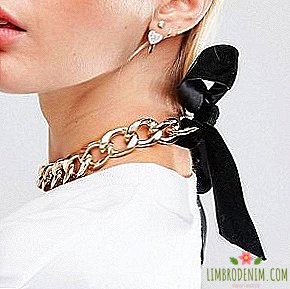Simplicity or theft: Why fashion brands copy each other
"Favorite designer Sobchak copied the collection unknown British fashion designer ", - with the title a few days ago an article appeared about the show of Alexander Terekhov Spring-Summer 2017. It was about a short shiny dress with one open shoulder, which was exactly the same as the Ashish Spring-Summer 2013 model. Actually," Sobchak’s favorite designer is Alexander Terekhov, and the “unknown British fashion designer” is Ashish Gupta, founder of the Ashish brand, whose Madonna, Miley Cyrus and Victoria Beckham wear recognizable things with sequins.

This article was not the only publication dedicated to this, well, coincidence. But she perfectly illustrated how difficult it is to comprehend plagiarism in 2016, when "everything was already invented by someone." It’s not even the case that someone stole a dress - this fact, of course, will not change either the fashion world or the lives of those who care about it. It is much more interesting that a simple question fails to find an intelligible simple answer: where is the line between undisguised theft, the secondary and the postmodern quote? And if stealing ideas is definitely not good, then why does this happen with unenviable regularity?
Apple is endlessly suing Samsung, Christian Louboutin continues to sue designers who painted the sole in red, and politicians steal from each other agitation speeches. You can't put an idea in a safe, so stealing it is easy, but it is difficult to prove the fact of theft. And especially there is no such hell where special boilers are prepared for fashionable plagiarists. For example, a couple of years ago, Roberto Cavalli was emotionally accusing Michael Kors of plagiarism: he was not talking about a dress or shoes, but about the very essence of the Michael Kors brand, built on secondary ideas.
And so it is: from season to season Kors shows a cocktail of well-edited, but still ready-made ideas. Here are just a committee of morality did not descend into Michael Kors, and the brand’s bags did not collapse in sales tops. Because the brand is not only an original artistic vision. These are lined up relations with the press and ambassadors, these are well-established trade networks, production and supply chains, sales, direct work with the consumer. No matter how strange it may sound, the lack of uniqueness can be quite the official basis of the brand - especially if you recall the catch phrase about "stealing talent".
You can’t put an idea in a safe, so it’s easy to steal it, but it’s difficult to prove the fact of theft.
As a result, it turns out that it is as though possible to steal someone, but to someone it does not. And here we step on the shaky soil of reputation. The mechanisms of production, sales and promotion of democratic and luxury brands differ markedly. In particular, mass-market customers more often buy “just clothes”, and a person aiming to invest in expensive things not only buys clothes, but also status, lifestyle, service and outstanding design, after all. This is a rather boring, even superfluous information for the consumer, who perceives clothes functionally. This is what makes clothes different from fashion: the latter has never been a story about “just dresses”. In the middle of the 20th century, designers like Christian Dior were driven out of a show of people who were trying to sketch things from the new collection into their notebook.
Then the brands for terrible money sold the large department stores the right to replicate those or other models. Both Christian Dior clients and department store clients paid for more than just getting new clothes. They paid for clothes "from Dior" (or "almost from Dior"), because his idea of femininity was then the most fashionable, and therefore they automatically became the most fashionable. Since then, nothing has changed. Yes, we learned how to build a wardrobe without the help of glossy tips and feel great in a gray sweatshirt even at an important event. However, when it comes to designer clothes with the capital "d", we still want the same thing that Dior's clients wanted - a feeling of being used to fashion.
A premium brand built on secondary ideas, however, can also give it, if it positions itself honestly - as a brand of beautiful clothes. Michael Kors never called himself a great couturier, who organizes seances with the spirit of Alexander McQueen. Even mass-market brands, who steal not so elegantly and ask for it not so much, regularly pay compensation, at the same time, for every accusation of plagiarism, answering: "Well, then we are a mass market with turtlenecks for two thousand rubles ". It is difficult to resist this impudent honesty: thus, the fact of secondary nature is “sewn into” the customer’s expectations from the very beginning. As practice and sales volumes show, it pushes few away.
The scandal usually flares up where people find an impostor brand - a brand that works with the same blue-eyed straightness, positioning itself with a much greater pretense. The things of Alexander Terekhov are in the same price category with Ashish, they glow in the Russian Vogue, they are loved by Russian-speaking fashion journalists and rich secular girls. Oksana Lavrentyeva, whose company “Rusmoda” is engaged in the Alexander Terekhov brand, in the above-mentioned material says: “Perhaps Alexander once saw this dress of a British designer, but he didn’t copy it. For example, when you create something, you do not even realize that you have already seen it somewhere. Therefore, it cannot be called plagiarism. "
Those accused of plagiarism love to talk about postmodernism.
So before us is a naked artist who cannot remember the original source - there are so many ideas in his head. Maybe he stole it, or maybe it seemed. Representatives of the brand did not respond to our request, in the pages of other publications the designer also did not comment on the case of plagiarism, did not say anything in the spirit of "I want to make women beautiful and think only about their pleasure, and not about ideas." He just ignored it.
Those who are accused of plagiarism, like to talk about postmodernism. As if call plagiarism a beautiful word - and it is locked. Elena Stafieva wrote excellently about the difference between the postmodern approach and thoughtless copying: “Yes, everyone is dragging everyone, but some are pulling with meaning, and some are without. And it is important not to lose sight of all conversations about“ postmodernism. ”Quote - it’s not embarrassing if you have your own author’s context. And if you don’t have it, then you get a stupid copy instead of quoting. Strange and in some places repulsive Vetements so exalted by critics, because Demna not only copied early Martin Marghela - he missed this aesthetics through his own view of the world, made it more commercial and added something of its own (the bitterness of a Soviet person to the whole world). Even with the general similarity of Maison Martin Margiela and Vetements, we are dealing with two different visions and two different approaches to fashion.
And, in parallel, a fresh scandal: first on Facebook, and then on the pages of Buro 24/7, Russian journalists scolded Lumier Garson, the young brand of Jean Rudow, which is completely built on compiling models of Vetements, Off-White and Raf Simons. But at the same time a collection of the brand puts Business of Fashion and Vogue.com. So was the fact of intellectual theft? Was. Even Jean himself doesn’t hide it: “I deliberately achieved all these comparisons and parallels with Vetements. In order to cause a resonance and get any feedback, it was necessary to make a mini-scandal. And I think I did it.”
The idea really worked: the Lumier Garson autumn-winter collection was written ten times more than all the previous ones taken together. Jean says that he is not going to use such methods anymore, but for now one can only believe him by word. If the designer already now, for example, said that he wanted to make Vetements for the people (that is, cheaper), then everything would be clear right away: honest work with the trend. But Jean wants to "stay within the framework of a small format, release things in small batches so that they remain relatively inaccessible." As long as he has a great response in the press and the opportunity to sell an invented copyright, time will tell how he uses it.
The phenomenon of theft of visual information is difficult. It is not clear how to regulate it and what to consider to be theft in the legal sense. It seems that the case with Terekhov and Ashish cannot be called controversial, because the dresses are almost identical, and one appeared three years later than the other. But in fact, the argument "they are similar" in the legal field does not work. In the case of cut or print, you can patent only the form.
The idea of a patent will not apply, and if you add berries to the print of the leaves or shift the elements by a couple of millimeters, you get a completely different picture. Of course, there is a moment of association with the brand - Louboutin won the right to monopoly in the world of red soles. Only for such claims it is necessary to collect a focus group, which unanimously confirms that the red sole associates with it exclusively with your brand, and if another brand makes it, the buyer will get confused.
Large brands constantly use their privileged position in relation to smaller brands.
Solving the problems of plagiarism in fashion through the court is also difficult because different brands are in a different position. If the team of Michael Kors had changed its careful approach to borrowing and sewed an exact copy of the Louis Vuitton dress, the brands, by virtue of their size, would at least be judged on equal terms. And what can we do, say, to Russian designer Vika Gazinskaya, when Kenzo produces a print that is remarkably similar to her, or if Stella McCartney has wooden crystals that were on Vika Gazinskaya sweatshirts a few years earlier and that seemed to be photographed by all known street styles photographers? Nothing. The fact of intellectual theft in this case is almost impossible to prove.
Firstly, this could be the omission of someone from the huge team of the brand giant, which relies on the creation of collections and on the trends from the streets too: what if a junior designer saw crystals, did not recognize the authorship and decided to be inspired by them? Secondly, the argument "yes, we hear about your brand for the first time" unfortunately works. Large brands constantly use their privileged position in relation to smaller brands.
When Zara once again intellectually robbed two dozen independent illustrators at the beginning of this year, the company's main argument was uncompromising: “The lack of a pronounced individuality in the design of your customer’s products makes it difficult to understand how the vast majority of people from different parts of the world can draw a parallel between us and Tuesday Bassen. " A representative from Zara sent such a response to an indie-jewelery lawyer Tuesday Bassen. And he backed up his letter with figures: the site of Zara is visited every month by 98 million people, the site of Bershka - 15 million against Tuesday Bassen with 160 thousand subscribers on instagram. A clearly expressed individuality to reliably measure no one has yet succeeded. Some of the jewelry was removed from sale, but the position of Zara probably remained unchanged.
Intellectually robbed it is easier to console oneself with a public scandal and try to cover the dishonest brand with shame. More balanced measures require time, money, effort and do not guarantee a positive result. Does the fact of intellectual theft affect sales of a dishonest brand? Not. Did the income of Balmain, for which in 2015 Olivier Rousten “invented” an exact copy of the 20-year-old Givenchy suit, have fallen? No matter how: Balmain has never had such a successful year - a collaboration with H & M, big sales, happiness, people's love.
We again stumbled upon a simple question: why then it is impossible to steal? The answer is very simple: you can, but the decision remains with us. Mass market and brands with democratic positioning steal openly. Unscrupulous expensive brands whose designers parasitize on other people's ideas are stolen in the hope that "no one will notice." In 2016, very, too much, too many things, and every purchase (especially an expensive one) is also an intellectual choice. Today, fashion critics and the turbulence of fashion presses no longer affect sales, so only the buyer regulates the behavior of brands. In this situation, it would be nice to know exactly what we are buying. When buying a stolen item, we invest in a global lie, the victim of which we ourselves are. A matter of taste, of course, but agree that this is a strange way to spend money.
Photo: Christian louboutin





